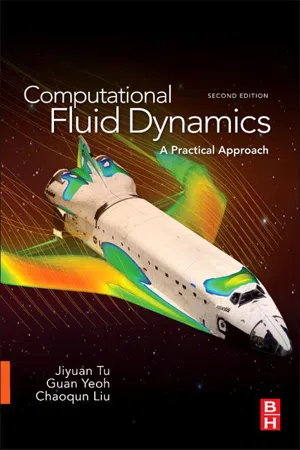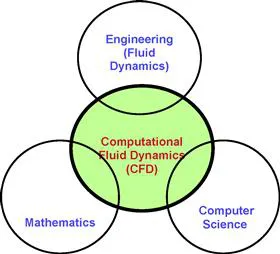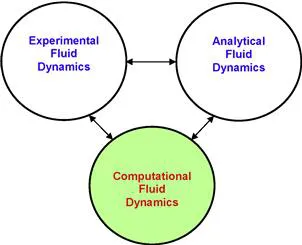1.1 What is computational fluid dynamics?
Computational fluid dynamics has certainly come of age in industrial applications and academic research. In the beginning, this popular field of study, usually referred to by its acronym CFD, was only known in the high-technology engineering areas of aeronautics and astronautics, but now it is becoming a rapidly adopted methodology for solving complex problems in modern engineering practice. CFD, which is derived from the disciplines of fluid mechanics and heat transfer, is also finding its way into important uncharted areas, especially in process, chemical, civil, and environmental engineering. Construction of new and improved system designs and optimization carried out on existing equipment through computational simulations are resulting in enhanced efficiency and lower operating costs. With the concerns about global warming and the world’s increasing population, engineers in power-generation industries are heavily relying on CFD to reduce development and retrofitting costs. These computational studies are currently being performed to address pertinent issues relating to technologies for clean and renewable power as well as for meeting strict regulatory challenges, such as emissions control and substantial reduction of environmental pollutants.
Nevertheless, the basic question remains: What is computational fluid dynamics? In retrospect, it has certainly evolved, integrating not only the disciplines of fluid mechanics with mathematics but also computer science, as illustrated in Figure 1.1. Let’s briefly discuss each of these individual disciplines. Fluid mechanics is essentially the study of fluids, either in motion (fluid in dynamic mode) or at rest (fluid in stationary mode). CFD is particularly dedicated to the former, fluids that are in motion, and how the fluid-flow behavior influences processes that may include heat transfer and possibly chemical reactions in combusting flows. This directly applies to the “fluid dynamics” description appearing in the terminology. Additionally, the physical characteristics of the fluid motion can usually be described through fundamental mathematical equations, usually in partial differential form, which govern a process of interest and are often called governing equations in CFD (see Chapter 3 for more insights). In order to solve these mathematical equations, computer scientists using high-level computer programming languages convert the equations into computer programs or software packages. The “computational” part simply means the study of the fluid flow using numerical simulations, which involves employing computer programs or software packages performed on high-speed digital computers to attain the numerical solutions. Another question arises: Do we actually require the expertise of three specific people from each discipline—fluids engineering, mathematics, and computer science—to come together for the development of CFD programs or even to conduct CFD simulations? The answer is that it is more likely that a person who proficiently obtains more or less some subsets of the knowledge from each discipline can meet the demands of CFD.
Figure 1.1 The different disciplines involved in computational fluid dynamics.
CFD has also become one of the three basic methods or approaches that can be employed to solve problems in fluid dynamics and heat transfer. As demonstrated in Figure 1.2, the approaches that are strongly interlinked do not work in isolation. Traditionally, both experimental and analytical methods have been used to study the various aspects of fluid dynamics and to assist engineers in the design of equipment and industrial processes involving fluid flow and heat transfer. With the advent of digital computers, the computational (numerical) aspect has emerged as another viable approach. Although the analytical method is still practiced by many, and experiments will continue to be significantly performed, the trend is clearly toward greater reliance on the computational approach for industrial designs, particularly when the fluid flows are very complex.
Figure 1.2 The three basic approaches to solve problems in fluid dynamics and heat transfer.
In the past, potential or novice users would probably have learned CFD by investing a substantial amount of time in writing their own computer programs. With the increasing demands from industries or even within academia to acquire knowledge of CFD in a much shorter time, it is not surprising that interest in writing original computer programs is waning, in favor of using more commercially available software packages. Multi-purpose CFD programs are gradually earning approval, and with the advancement of models to better encapsulate the flow physics, these software packages are also gaining wide acceptance. There are numerous advantages in applying these computer programs. Since the mundane groundwork of writing and testing the computer codes has been thoroughly carried out by the “developers” in the respective software companies, today’s potential or novice CFD users are relieved of dealing with these issues. Commercial programs can be readily employed to solve numerous fluid-flow problems.
Despite well-developed methodologies within the computational codes, CFD is certainly more than just being proficient in operating software packages. Bearing this in mind, the primary focus of this book is, therefore, to educate potential or novice users in how to employ CFD judiciously, so the text aims equally at supplementing the understanding of underlying basic concepts and at the technical know-how in better tackling fluid-flow problems. Users who are inclined to pursue postgraduate research or are currently undertaking research through the development of new mathematical models to solve more complex flow problems should consult other CFD books (e.g., Fletcher, 1991, Anderson, 1995, Versteeg and Malalasekera, 1995) and our future book, in which we intend to concentrate on presenting a step-by-step procedure for initially understanding the physics of new fluid dynamics problems at hand, developing new mathematical models to represent the flow physics, and implementing appropriate numerical techniques or methods to test the models in a CFD program.
CFD has indeed become a powerful tool that can be employed either for pure/applied research or for industrial applications. Computational simulations and analyses are increasingly performed in many fluid-engineering applications, which include aerospace engineering (airplanes, rocket engines…), automotive engineering (reducing drag coefficients for cars and trucks, improving air intake in engines…), biomedical engineering (blood flow in artificial hearts and, through scent flow, air flow in breathing…), chemical engineering (fluid flow through pumps and pipes…), civil and environmental engineering (river restoration, pollutant dispersion…), power engineering (improving turbine efficiency, wind farm siting and performance prediction…), and sports engineering (swimming equipment, golf swing mechanics, reducing drag in biking…). Through CFD, one can gain an increased knowledge of how system components are expected to perform, so as to make the required improvements for design and optimization studies. CFD actually asks the question “What if …?” before a commitment is undertaken to execute any design alteration. When one ponders the planet we live on, almost everything revolves in one way or another around a fluid or moves within a fluid.
CFD is also revolutionizing the teaching and learning of fluid mechanics and thermal science in higher-education institutions through visualization of complex fluid flows. Development of CFD-based software packages to be more user-friendly is allowing students to visually reinforce the concepts of fluid flow and heat transfer. The software allows teachers to create their own examples or to customize predefined existing ones. With carefully constructed examples, students are introduced to the effective use of CFD for solving fluid-flow problems, and they can develop an intuitive feel for flow physics. In the next section, we discuss some important advantages of CFD and further expound on how CFD has evolved and is applied in practice.
1.2 Advantages of computational fluid dynamics
With the rapid advancement of digital computers, CFD is poised to remain at the forefront of cutting-edge research in the sciences of fluid dynamics and heat transfer. Also, the emergence of CFD as a practical tool in modern engineering practice is steadily attracting much interest.
There are many advantages of computational fluid dynamics. First, the theoretical development of the computational sciences focuses on the construction and solution of the governing equations and the study of various approximations to these equations. CFD presents the perfect opportunity to study specific terms in the governing equations in a more detailed fashion. New paths of theoretical development are realized which could not have been possible without the introduction of this computational approach. Second, CFD complements experimental and analytical approaches by providing an alternative cost-effective means of simulating real fluid flows. Particularly, CFD substantially reduces lead times and costs in design and production compared with experimentally based approaches and offers the ability to solve a range of complicated flow problems where the analytical approach is lacking. These advantages are realized through the increasing performance power of computer hardware and its declining costs. Third, CFD has the capacity to simulate flow conditions that are not reproducible in experimental tests found in geophysical and biological fluid dynamics, such as nuclear accident scenarios or scenarios that are too huge or too remote to be simulated experimentally (e.g., the Indonesian Tsunami of 2004). Fourth, CFD can provide detailed visualization and comprehensive information when compared to analytical and experimental fluid dynamics.
In practice, CFD permits alternative designs to be evaluated over a range of dimensionless parameters that may include the Reynolds number, Mach number, Rayleigh number, and flow orientation. The utilization of such an approach is usually very effective in the early stages of development for fluid-system designs. It may also prove to be significantly less expensive than the ever-increasing spiraling cost of performing experiments. In many cases, where details of the fluid flow are important, CFD can provide detailed information and understanding of the flow processes to be obtained, such as the occurrence of flow separation or whether the wall temperature exceeds some maximum limit. With technological improvements and competition requiring a higher degree of optimal designs, and as new high-technology applications demand precise prediction of flow behaviors, experimental development may eventually be too costly to initiate. CFD presents an alternative.
Nevertheless, the favorable appraisal of CFD thus far does not suggest that it will soon replace experimental testing as a means for gathering information for design purposes. Rather, it is considered to be complementary in solving fluid-mechanics problems. For example, wind-tunnel testing is a typical experimental approach that still provides invaluable information for the simulation of real flows at reduced scale. For the design of engineering components, especially for aircraft, which depend critical...


